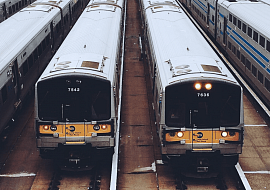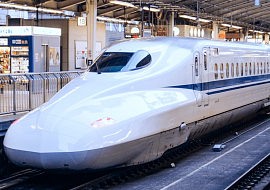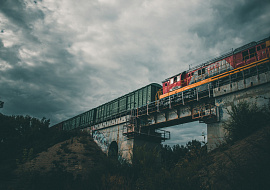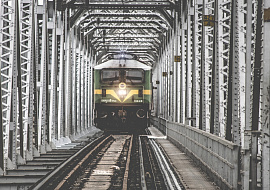How do I choose the right Rail Signaling Solutions in the Digital Age?
However, rail signaling shows extreme situations. While some market giants and ambitious startups are developing cutting-edge microprocessor signaling systems, many rail companies around the world still utilize relays in their signaling upgrade projects, operating similarly to the way they would have a century ago. This situation, caused by a lack of innovation in signaling systems, is sometimes called a signaling crisis. With that in mind, it’s often difficult to calculate who benefits more, innovators or conservatives. Because the world of signaling involves long-term and costly projects, any innovation may become obsolete before completion, meaning a realistic and practical approach is key to success.
Is it justifiable to utilize relay-based rail signaling solutions in the digital era, or could it be risky for follow-up and related projects? How can digitization influence signaling in the future? PSA shares our expertise from our 10+ years of rail signaling engineering, working at the junction of technologies, and helping companies avoid miscalculations in developing signaling projects.
Rail Signaling Solutions in the Digital Age: current status and new opportunities
The main benefit of digital technologies that became a pitfall for signaling is their rapidly evolving nature. With signaling systems implemented over 20 years ago, custom supporting solutions are always needed because the hardware becomes out of the market sooner than the end of the equipment's useful life. Although it concerns both outdated relay-based and digital microprocessor-based systems, the latter is much more flexible to be updated and provided with new features. The main features that digital has brought to signaling are:
-
Faster operations;
-
Self-diagnostics;
-
More data available;
-
Versatile connectivity potential;
-
Convenient data presentation on dispatchers’ monitors.
Considering that modern digital tools now enable the realization of predictive maintenance of railroad equipment, digital signaling seems to be a perfect solution also for improving the safety of train movements. However, as we noticed, even big fishes in the rail market are in no hurry to spread digital signaling on a large scale. Why does it happen, and is it a crisis globally? In one of our articles, we’ve previously discussed why the rail industry is so reluctant to innovate, but signaling is the most conservative part of the rail project. When choosing a rail signaling solutions, companies are still primarily influenced by the following factors:
-
The scale and duration of rail projects
-
The complexity of signaling development and implementation
-
The cost of signaling upgrades
Since signaling projects prevalently last over 4 years, include rail stations with over 10 rails, require tons of documentation review, and various types of connectivity, all these factors boil down to increased costs. According to recent estimates, signaling costs vary from $200 thousand to $800 thousand per kilometer while any rail upgrading project requires replacing thousands of signaling units. Rail signaling solutions are hard to monetize or even recoup the investment in a short period, hence, it is not surprising that rail companies neglect innovations in favor of extending the life of signaling equipment. We can make an assumption that signaling will accept a minimal feature set provided by analog relay-based equipment to last until possible.
There are already plenty of factors that can’t be ignored within some rail projects. Now let’s figure out where this pragmatic strategy is acceptable and where to consider digital more extensively.
How not to underestimate a digital need within the rail signaling solutions
How not to underestimate a digital need within the rail signaling solutions
We can’t call microprocessor systems innovative in general, but their digital nature makes them more aligned with today's digital world. Speaking of microprocessor systems, we also imply mixed systems utilizing solid-state relays controlled by microprocessors. The main benefits described above make the system suitable for congestion lines contributing to better train location tracking, optimizing space between trains, and increasing the number of trains within the rail line. Additionally, if these major benefits are obvious now for decision-makers within rail projects, there are some factors in the near future that won’t be so easily ignored in estimating some of them.
-
All signaling innovations are microprocessor-based. The enhanced rail signaling solutions are based on microprocessors of their higher connectivity potential. For instance, AutoHaul technology, which is based on radio signal digital connection, is suitable for ETCS level 2 which enables fully automated train operation; or a cloud-based signaling system that is being developed for the new Italian line by Hitachi and HyperloopTT. Also, new digital solutions that appear on the market are compatible with microprocessor systems which eases maintenance. For instance, we can improve system performance by replacing the outdated module, or providing wireless communication between vehicles and the wayside to track the trains’ location more precisely.
-
Advanced Analytics enables accurate predictive maintenance. Now, digital can bring many more benefits to the transportation sector than 20 or even 10 years ago, and this is primarily associated with advanced data analysis capabilities. By tracking train wheels, circuits, switches, and interlockings and measuring various parameters such as noises, vibrations, or temperature, rail companies not only have a complete real-time view of all the assets but pull all these data to analytical tools in the cloud to identify patterns and then forecast precisely when the equipment might fail. There are quite encouraging forecasts for maintenance savings via such tools, primarily through the possibility to avoid signaling failures.
-
Cities’ connectivity is improving. Smart cities are actively developing and gaining momentum in more regions every year. Rail seamless infrastructure, for instance, is one of the main priorities within a breakthrough Kaohsiung smart city project. To immediately react to signal issues for rerouting and rescheduling, trains need to be smartly coordinated, which naturally requires advanced connectivity and interactivity. In this case, every transport component, including signaling devices, has to provide the city with critical data, which is impossible for relay-based rail signaling solutions without additional costly customization.
-
Extra-speed trains can’t run on legacy signaling systems. Cutting-edge extra-speed trains are one more way to increase the capacity of the rail line but they require a special approach to organizing the signaling system. At speeds of more than 250 km per hour, relays simply can’t detect trains as quickly as it is required and need to be replaced with microprocessor-based GPS tracking systems.
-
Smart solutions are becoming more affordable. This is obvious that smart solutions can be unreasonably costly for large-scale implementation, but the situation can change at any moment. We advise rail company monitor not only the signaling market, but all the related components and technologies – processors, boards, communication protocols, and so on. At locations where relay-based systems would have been set due to budget-saving, one might choose microprocessors with higher processors if their cost had decreased. Also, it gives encouraging start-ups the chance to collaborate and bring a breaking new product to the market!
The extent to which these factors are taken into account depends on the nature and objectives of the project. Basically, rail companies need significant analytical resources to determine whether some of these factors are crucial for the perspective rail project and must be considered while performing signaling. However, if your project is not challenging with congestion, or intended to solve a specific issue very quickly, digital and analog systems can be considered equally, and we are talking next.
Need help implementing Rail Signaling Solutions?
Relays vs Microprocessors: Choosing rail signaling solutions pragmatically
Signaling upgrading is always troubleshooting whether a commuter rail in a new city region is suffering from increased traffic, or the life of the interlocking equipment is coming to an end in 5 years. If some outlying rail line is serving several trains a day, or for the rail line within an industrial enterprise, there is no need to look deep into the future. Having a clear objective, companies are guided by a pragmatic principle when choosing between the relay and microprocessor-based systems — to find the most productive rail signaling solutions requiring minimal costs.
CBTC, PTC, ETCS, and similar systems consider both relay-based systems with simple logic and microprocessor-based digital systems, operating on specific software as reliable enough to control interlocking equipment over modern rail lines. So far, when choosing between digital and analog, we should consider lots of factors, from traffic situation to landscape, or the condition of all the assets within the rail line. Further, we discuss the major features of both systems.
Exploitation and Maintenance
Although the relay-based signaling system is more affordable to be designed and developed, it is more power-consuming that the microprocessor-based. The bigger the rail project is, the more significantly this parameter is felt. Modernization for both systems eases the maintenance since new systems require less time on it, but digital equipment is even more convenient here thanks to its self-diagnostic nature. Is it possible to provide relays with such functionality? Surely, you can implement any sensors to them, but it also needs special software that would be much more expensive than microprocessor systems.
Both systems have a fail-safe nature that makes them reliable enough to withstand standards for signaling systems provided by the FRA. However, its smooth operation may be slowed down through signaling failures, which usually pull on $40,000, as Amtrak counted. To decrease their number, rail companies can realize predictive maintenance of all their assets by building the IoT ecosystem. Thanks to connectivity potential, microprocessor-based systems are more adapted for implementing Enterprise IoT solutions to monitor the status of signaling equipment in real-time and predict future failures.
Safety & Security
An obvious plus of relay-based systems is the impossibility to be hacked. The only danger is the risk of physical damage to equipment, but it can happen with any rail asset if the company has no reliable security system. Microprocessor systems can be in danger of interception of information, data theft, compromising security, and violation of signaling operations which is extremely critical for providing safety. They can suffer especially when critical data is transferred via Ethernet. Sure, all the microprocessor-based systems have security protection, and key management systems are provided to connect trains with wayside equipment securely. However, these systems always need to be supported, maintained, and updated to prevent new security issues, which leads to additional costs.
Location Features
Microprocessor systems are much more compact in general which might become a critical feature if there is simply no additional place on location, or the location conditions are inappropriate. Relay-based controlling equipment located in separate enclosures, or even buildings to provide control of the interlocking equipment over the station. However, in major rail hubs with heavy traffic microprocessor-based systems can take even more place than relay-based due to their amount. Also, relay systems are highly resistant to electromagnetic interference, lightning surges, and extreme climatic influences. Therefore, to decide on this, you should consider all the location factors too: free areas, landscape, climate, private areas, proximity to the other electrified objects, and so on.
How about related systems?
Since any rail project consists of at least 5 interdependent parts, you won’t want to decide on an interlocking control system without estimating the project as a whole and its approximate costs. For instance, intending to run extra-speed trains on the legacy rail line, you can agree on the appropriate signaling system for it, but the existing rail can’t bear such a burden. In this case, you need to replace them which will lead to other extra costs of construction. The same attaches to all the systems: in-cab, dispatching, platform, wayside, and communication. We have to estimate the influence of any solution on every system to confirm its seamless operation or agree on some improvements.
Conclusions
We suppose that sooner or later microprocessor-based systems will replace the relay-based. Although there is no need to hurry and replace all the outdated assets immediately, it’s better to be prepared for the digital signaling revolution.
- Until the rail industry dictates how fast digital signaling will be implemented globally, we are free to choose between relay-based and microprocessor-based systems considering their productivity in particular cases.
- If we need to solve a particular issue, such as increasing the capacity of the rail line, or the life of the interlocking equipment is coming to an end, we can consider both systems equally. If we build on perspective, considering possible new innovations, we advise on implementing microprocessor-based systems because of their higher susceptibility to innovations, flexibility, and adaptive nature.
- Relays are advisable to be utilized on low-traffic lines where microprocessors are economically disadvantageous. Also, they are highly resistant to electromagnetic interference, lightning surges, and extreme climatic influences.
- Microprocessors are clearly beneficial in cases of high congestion, within high-speed trains, or within IoT ecosystems.
Perhaps the rail signaling sector will be moved to digital last, but it will be a clear sign that digital has won completely and irrevocably. Still hesitating on which system to choose? PSA will help you to pick the appropriate rail signaling solutions as well as realize signaling design and testing for existing and new rail lines all over the world.















